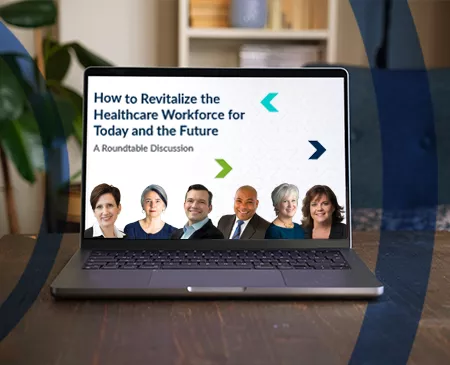Amid ubiquitous physician and nurse burnout, many healthcare organizations are grasping at tactics to help maintain their workforce. But few are doing so with sustained success. The good news is that a systematic approach focused on key practice-specific details has proven effective at addressing burnout and making organizations an employer of choice.
Dan Shapiro, PhD, is Director of the Chartis Center for Burnout Solutions. He started his career as a clinical psychologist and has extensive experience working with medical professionals suffering from burnout. He is the author of several academic articles and books on the topic and has spent the last decade partnering with health systems to systematically reduce burnout, improve retention, and foster wellness. When Dan isn’t working, you’ll find him wandering St. Petersburg with a camera.
Chartis: How can healthcare leaders best assess burnout among their workforce?
Dan Shapiro:
Organizations should be looking at burnout measurements specific to their organizations and at the specialty level.
One of the best-known benchmark studies is Medscape’s annual report on physician burnout. The 2023 report was released last month, and it includes national averages by specialty. This report can be a helpful barometer for the health of the industry.
But even broken out by specialty, the mean burnout rate is the wrong statistic for leaders to pay attention to.
Here’s why: While burnout is ubiquitous, there’s a wide variability from place to place. For instance, at one organization we assessed, burnout among anesthesiologists was 15%. At another organization, it was 60%. This variation reveals an underlying truth that the local practice details at the ground level are what really matter.
It’s not some inherent aspect of the specific specialty that’s driving burnout. It’s the circumstances around these healthcare professionals that are driving burnout—and those circumstances are amenable to change.
Organizations need to leverage practice-specific burnout assessments to truly understand the issue among their own workforce.
Chartis: What are the key components of a practice-specific burnout assessment?
Shapiro:
A range of factors drive burnout among physicians, nurses, and other healthcare professionals. At the most basic levels, these professionals need to work in an environment that meets their physical needs and ensures their safety. Things many people take for granted, like being able to eat meals at reasonable intervals and stay hydrated, are frequently overlooked.
Health systems often think an employee’s relationship with their manager will have the most significant impact. But if a nurse is hungry, dehydrated, hasn’t had regular access to a bathroom, and is dealing with violent patients, her relationship with her manager isn’t the most important thing in her professional environment.
Healthcare organizations need to ensure that the full spectrum of their employees’ needs are appropriately met if they are going to meaningfully address burnout.
When we survey a given population of a healthcare workforce, we use a modified version of Maslow’s Hierarchy to make sure we are gaining a full picture of how well these employees’ needs are being met and to identify the changes that will matter most.
Chartis: How do practice-specific burnout surveys differ from employee engagement surveys?
Shapiro:
A lot of health systems are conducting engagement surveys with their workforce. But most of these surveys have 2 significant problems: (1) overall, the insights aren’t actionable, and (2) the effort isn’t systematic. The result is that execution tends to fall to the lowest level manager, who often isn’t able to make meaningful changes—if any at all.
Another key element that often isn’t part of employee engagement surveys is tailoring the surveys to each specialty. This level of specificity allows leaders to pinpoint particular practice details at the ground level that can be changed—and zero in on changes that will matter most. Then, leaders also need to tailor their interventions accordingly.
Chartis: What are some survey findings that tend to come as a surprise to healthcare leaders?
Shapiro:
The most alarming surprise is the high rate of full-blown post-traumatic stress disorder (PTSD), especially among physicians and nurses who have worked in Emergency Departments or critical care units. We’ve worked with units where the rate was 22%, which is higher than the PTSD rates of soldiers returning from Vietnam or the Gulf War. So many witnessed tremendous tragedy with a front-row seat—especially in recent years. PTSD is a very serious mental health issue that can be profoundly debilitating. But when organizations identify it among their workers, they have an opportunity to quickly deploy resources for the individuals who need them.
Another finding that most often surprises leaders is how often healthcare professionals have to hold their pee for more than an hour. Unless they were active clinicians themselves, many healthcare leaders don’t have to deal with that very basic issue, and it can easily be overlooked.
And a finding that affects overall wellness is how few nurses and physicians have their own primary care providers. Primary care is the entry point for mental health care and routine health screenings, and it’s problematic when people don’t have it.
Leaders need to understand that healthcare professionals have been acculturated to deny their own needs. Most of these individuals are not going to reach out for help when they need it. The organization needs to proactively understand where those needs are and systematically make the necessary changes and monitor progress.
Chartis: What does it mean to systematically address burnout?
Shapiro:
Conducting systematic employee burnout surveys is the starting point. There’s an intentionality from the beginning to pinpoint the systemic problems and a commitment to making the necessary changes, not just for one employee or one team but wherever it is an identified need.
When we partner with healthcare organizations to improve burnout and wellness, we create prioritized dashboards based on data harvested from inventories and other internal sources. These dashboards highlight where change needs to start, and the dashboards then report improvements when we conduct follow-up pulse surveys.
For example, in one survey, nurses in a specific unit shared that they felt like they were having to dress up like ninjas and go steal supplies from adjacent units because their supplies were never where they were supposed to be. They were wasting a tremendous amount of time, energy, and effort doing that. Supply chain issues were a big contributing factor to burnout for these nurses, and the organization needed to prioritize addressing them.
In another system, leaders treated their cafeterias like independent profit centers and closed them at 7:00 p.m., instead of considering their cafeterias as the best source of healthy calories for their night workers. When healthcare workers skip meals or get dehydrated, their mood and cognition worsens.
Chartis: What can leaders do to address burnout in a way that delivers lasting improvement?
Shapiro:
Many healthcare leaders feel overwhelmed by burnout, with a sense of personal responsibility for it. The good news is that burnout, and even PTSD, doesn’t need to cause healthcare professionals to leave the organization or the profession. There’s a lot of low-hanging fruit and actionable work that improves burnout and retention.
We have seen dramatic improvements at health systems, especially in nurse turnover. One organization went from a 22% turnover down to 11%. And in a large group of academic physicians, turnover dropped from 16% to 10%. These represented savings in the millions of dollars in labor costs and improved wellbeing of these healthcare professionals.
By taking a systematic, actionable approach to burnout, leaders can turn the experience of their workforce on its head. Instead of battling burnout, healthcare professionals at these organizations can love working in their profession—and love being in their workplace.




